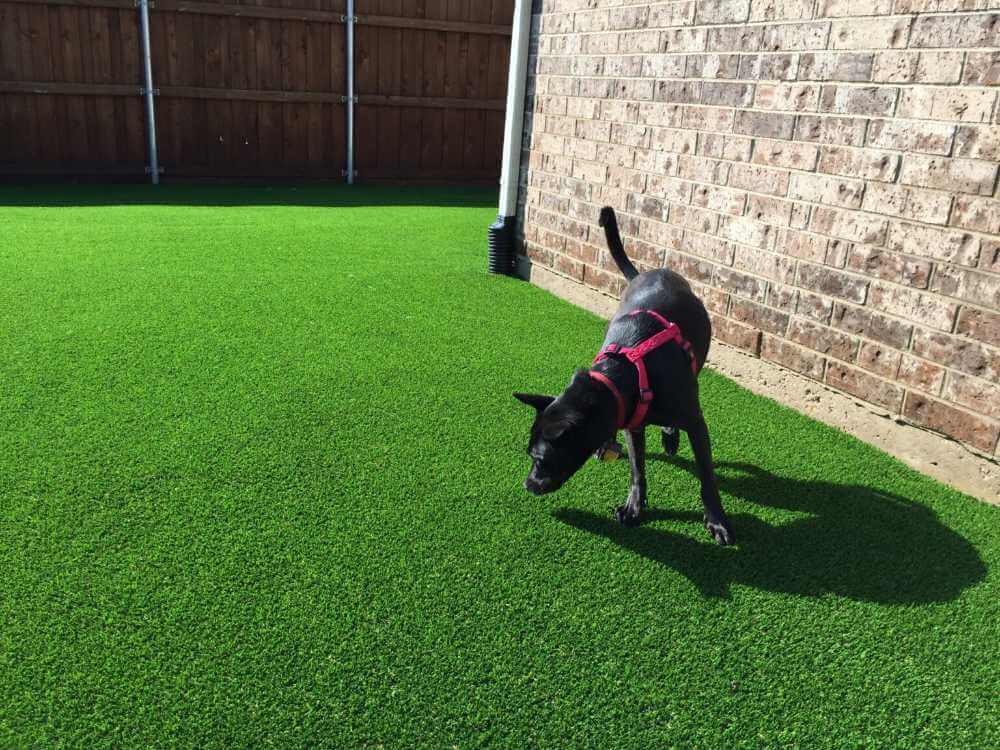
Pets can put stress on a natural grass lawn. The constant paw traffic in heavily used areas can wear grass thin or kill it completely. And the dirt left behind can turn into a muddy mess when it rains. Pets can also dig holes in natural lawns, dig under fences, or burn the grass with their urine. It can take a great deal of planning and maintenance to keep a natural grass lawn looking its best. These are but a few reasons why Artificial Grass could be advantageous for pet owners.
There seem to always be new and potentially better solutions for keeping pets healthy, clean, and safe. Artificial Turf may be a convenient and practical option for pet owners to address this need. It may be just the solution for maintaining a good-looking lawn with minimal impact from pets. Below are some benefits and considerations to keep in mind for ensuring a safe and comfortable environment for pets if Synthetic Grass is installed.
Artificial Grass Benefits
- Durability: High-quality artificial grass for pets is designed and manufactured to be durable enough to resist the wear and tear of pet activity such as scratching, digging, and walking/running over the same path over and over.
- No Mowing: Artificial grass requires no mowing. That can be music to many ears. Gone will be the hours of mowing required each week to properly maintain a natural grass lawn. Those hours typically spent mowing can instead be spent participating in more desired activities.
- No Dirt or Mud: Synthetic grass doesn’t create any dirt or mud, so pets are much less likely to track soil into the house. This can be overly advantageous for pet owners in wet climates or during moisture-laden times of the year. This will save on floor upkeep, paper towels, and hand towels used for wiping off feet.
- Easy to Clean: Artificial turf is typically easier to clean off than natural grass. Solid waste is easily removed and disposed of and urine or vomit can readily be rinsed off with a hose. Routine maintenance such as rinsing and brushing will help keep the artificial grass clean and odor-free.
- No Lawn Chemicals or Pesticides: Unlike all the chemicals and pesticides needed to properly maintain a natural lawn, artificial grass doesn’t require fertilizers, pesticides, or herbicides, so there is a major reduction in potential exposure to harmful chemicals for both pets and their owners. And the days of pulling or killing weeds will be a distant memory.
- Little Water: Since artificial turf isn’t alive and therefore doesn’t grow, it needs no water to survive. It benefits from a water hose rinse off now and again and once a week for heavy pet use, but synthetic grass saves water and money and helps protect our natural resources.
- Less Allergens: Since synthetic turf doesn’t produce pollen like many grasses do, it can help reduce allergic reactions to grass pollen from pets. This is particularly beneficial for pets with allergies and may help prevent grass allergies from developing in the first place.
- Good Longevity: A quality artificial grass lawn can last 15 to 20 years with proper maintenance. This is a long time to have a consistently green lawn without having to spend money on watering, mowing, chemicals, pesticides, grass seed, aeration, and other maintenance typically required for the proper maintenance of natural grass lawns.
- Handles any Weather: No matter if Mother Nature dishes out rain, hail, sleet, ice, or snow, artificial grass can handle any weather condition with ease. Whereas natural grass suffers in these weather conditions, goes dormant, and sometimes needs to be replanted, synthetic grass weathers all storms and continues producing a vibrant, green, and healthy-looking lawn.
- Drainage: Artificial turf is specially designed with perforations to drain away excess water or liquids. The turf is manufactured with many small drainage holes so water is whisked downward and away as quickly as possible. In addition, some installations may utilize a drainage system beneath the turf.
Synthetic Grass Considerations
- Non-Toxic Materials: Ensuring that the artificial grass chosen is made from non-toxic materials will provide a safe environment for pets and family members since pets and kids both like to play on the ground. Some older synthetic turf may have had some issues, but newer turf has come a long way.
- Cooling Properties: In hot climates, synthetic grass can become pretty warm during the middle of the day and become uncomfortable for pets. Some turf products are designed with cooling technology to reduce surface temperatures. Artificial turf can also be hosed down, shaded, or placed under trees to eliminate this issue.
- Infill Type: Some artificial grass projects use infill material to provide support and stability for the turf. Be sure that the infill material is safe for pets and if ingested, doesn’t pose a health risk.
- Quality Installation: The proper installation of artificial grass is key to its longevity and performance over time. The synthetic turf must be securely installed, especially along the edges and in the corners to prevent lifting or damage from pet scratching or digging in those areas.
- Supervision: While typically safe for pets, artificial grass usage should be supervised, especially for puppies or dogs prone to chewing on surfaces.
- Regular Inspection: While artificial turf is virtually maintenance-free, periodic inspection of the turf for signs of wear and tear or insect infestations is important for maintaining a quality turf yard or area.
In summary, artificial grass can be a great pet-friendly turf option when properly chosen and installed for the right surface and pets. And it can save a lot of time and money long-term versus natural turf. When considering your pet’s needs, the climate type, and the quality of the synthetic grass products available, your pet will be ensured of having a comfortable, clean, and healthy environment in which to roam.